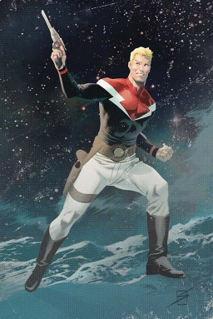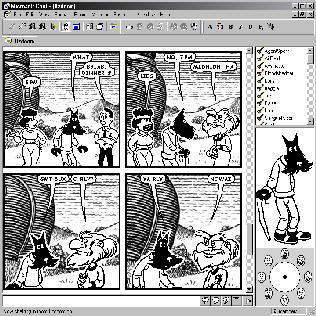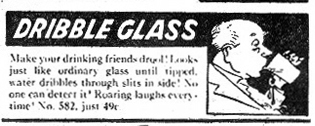See also
- X-Ray Spex, an English punk band
| This disambiguation page lists articles associated with the title X-Ray Specs. If an internal link led you here, you may wish to change the link to point directly to the intended article. |
X-ray specs are a type of novelty eyewear, purported to allow the user to see through or into solid objects.
X-ray specs are American novelties, purported to allow users to see through or into solid objects. In reality, the spectacles merely create an optical illusion; no X-rays are involved. The current paper version is sold under the name "X-Ray Spex"; a similar product is sold under the name "X-Ray Gogs".
X-Ray Specs may also refer to:
X-Ray Specs was a British comic strip illustrated by Mike Lacey that appeared in the first issue of the British comic Monster Fun on 14 June 1975. It features a young boy who acquired a set of X-Ray spectacles with whom he could see through everything.
The following is a comprehensive discography of British rock band Sweet.
| This disambiguation page lists articles associated with the title X-Ray Specs. If an internal link led you here, you may wish to change the link to point directly to the intended article. |

A comic strip is a sequence of drawings arranged in interrelated panels to display brief humor or form a narrative, often serialized, with text in balloons and captions. Traditionally, throughout the 20th century and into the 21st, these have been published in newspapers and magazines, with horizontal strips printed in black-and-white in daily newspapers, while Sunday newspapers offered longer sequences in special color comics sections. With the development of the internet, they began to appear online as webcomics. There were more than 200 different comic strips and daily cartoon panels in South Korea alone each day for most of the 20th century, for a total of at least 7,300,000 episodes.

Flash Gordon is the hero of a space opera adventure comic strip created by and originally drawn by Alex Raymond. First published January 7, 1934, the strip was inspired by, and created to compete with the already established Buck Rogers adventure strip.

The Phantom is an American adventure comic strip, first published by Lee Falk in February 1936. The main character, the Phantom, is a fictional costumed crime-fighter who operates from the fictional African country of Bangalla. The character has been adapted for television, film and video games.

Microsoft Comic Chat is a graphical IRC client created by Microsoft, first released with Internet Explorer 3.0 in 1996. Comic Chat was developed by Microsoft Researcher David Kurlander, with Microsoft Research's Virtual Worlds Group and later a group he managed in Microsoft's Internet Division.

The Numskulls is a comic strip in The Beano, and previously in The Beezer and The Dandy – UK comics owned by D.C Thomson. The strip is about a team of tiny human-like technicians who live inside the heads of various people, running and maintaining their bodies and minds. It first appeared in The Beezer from 1962 until 1979, drawn by Malcolm Judge.

Buster was a British comic which carried a mixture of humour and adventure strips, although the former increasingly replaced the latter. It was originally published by IPC Magazines Ltd; but in consequence of the sale of that company's comics division, Fleetway, in the 1980s, Buster passed into the ownership of Egmont UK Ltd, who thereafter published it under the Fleetway imprint. There were a few missing months and weeks worth of issues due to strikes. There were 1,902 issues in total.

Monster Fun was a weekly British comic strip magazine for children aged seven to twelve. Published by IPC Media, it ran for 73 issues in 1975–1976, when it merged with Buster. Focused on humorous monster strips and stories, the magazine was known for "The Bad Time Bedtime Books" minicomic inserts, created by Leo Baxendale.
In science fiction stories or Superhero comics, X-ray vision is the ability to see through physical objects at the discretion of the holder of this superpower. The most famous possessor of this ability is DC Comics' iconic superhero character, Superman.
Emmanuel "Mac" Raboy was an American comics artist best known for his comic-book work on Fawcett Comics' Captain Marvel Jr. and as the Sunday comic-strip artist of Flash Gordon for more than 20 years.

Secret Agent X-9 was a comic strip created by writer Dashiell Hammett and artist Alex Raymond. Syndicated by King Features, it ran from January 22, 1934 until February 10, 1996.

The Sunday comics or Sunday strip is the comic strip section carried in most western newspapers, almost always in color. Many newspaper readers called this section the Sunday funnies, the funny papers or simply the funnies.
Secret Agent X-9 (1937) is a Universal film serial based on the comic strip Secret Agent X-9 by Dashiell Hammett and Alex Raymond.
Richie Wraggs was a comic strip character in the British comic Jackpot. He appeared with his black cat, Lucky.

Olga Mesmer is a superpowered fictional character in a pulp magazine's comic strip published from 1937 to 1938. Like the newspaper comic-strip character Popeye (1929) and novelist Philip Wylie's protagonist Hugo Danner (1930), she is among the precursors of the archetypal comic-book superhero, Superman.

Suicide Squad: Hell to Pay is a 2018 American animated superhero film produced by Warner Bros. Animation and distributed by Warner Bros. Home Entertainment. The film is directed & produced by Sam Liu, with scripting by Alan Burnett. It is the 31st film in the DC Universe Animated Original Movies series and a part of the DC Animated Movie Universe. The voice cast includes Christian Slater as Deadshot, Tara Strong as Harley Quinn and Vanessa Williams as Amanda Waller. The film was released digitally on March 27, 2018 and released on DVD and Blu-ray on April 10, 2018.

Comic book advertisements are a common feature in American comic books mainly from the 1940s onwards. As these advertisements were directed at young people, many made sensational claims, and sold the products for a few dollars to be sent to a post office box. Products offered included novelty items, toys, and self-improvement courses such as drawing and body building.